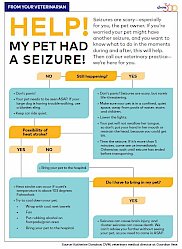Seizures
Watching your pet experience a seizure is both frightening and disturbing, especially if it is a new experience. There is collapse, involuntary movement, and often loss of consciousness followed by a period of daze and disorientation. Prolonged seizure activity constitutes an emergency.
What is a Seizure and How Do you Know if your Dog has Had One?
A seizure results from excessive electrical activity in the cerebral cortex of the brain. The electrical activity starts in one area (called the seizure focus) and spreads in a process called kindling. Classically, the patient loses consciousness, collapses, becomes stiff at first and then begins paddling or struggling, but seizures can take many forms. Any involuntary behavior that occurs abnormally may represent a seizure. Seizures are classified into several categories.
Generalized (Grand Mal) Seizures
This is the most common form of seizure in small animals. The entire body is involved in stiffness and possibly stiffness/contraction cycles (tonic/clonic action). The animal loses consciousness and may urinate or defecate.
Focal Seizures (Also Called Partial Motor Seizures)
Focal seizures involve involuntary activity in only one body part. Consciousness may or may not be impaired. A classic example would be the "chewing gum" fit that frequently is seen in canine distemper infections but can be seen in other seizure disorders as well.
Psychomotor Seizures
Psychomotor seizures are focal seizures where the seizure is more like an episode of abnormal behavior than an actual convulsion. The pet's consciousness is disturbed by this type of seizure as the pet appears to be hallucinating or in an altered state. The seizure may include episodes of rage or aggression where the pet does not recognize family members, paces or runs in circles or may be as simple as a brief episode of disorientation or spacing out.
Components of a Seizure
A seizure occurs in three phases:
- The pre-ictal phase, or aura, is a period of altered behavior in which the dog may hide, appear nervous, or seek extra attention from people it knows. It may be restless, nervous, shaking, or salivating. This may last a few seconds to a few hours.
- The ictal phase describes the seizure itself and lasts from a few seconds to five minutes. During this period, all of the muscles of the body contract strongly. The dog usually falls on its side and seems paralyzed while shaking. The head will be drawn backward. Urination, defecation, and salivation often occur. If it is not over within five minutes, the dog is said to be in _status epilepticus_, or a prolonged seizure.
- During the post-ictal phase, there is confusion, disorientation, salivation, pacing, restlessness, and/or temporary blindness. There is no direct correlation between the severity of the seizure and the duration of the post-ictal phase.
Seizures (neurological events) are often difficult to tell from fainting spells (cardiovascular events). The seizure is also typically followed by a post-ictal period. In contrast, fainting animals are usually up and normal within seconds of the spell, with no post-episode disorientation.
Dogs that do not receive medical attention with _status epilepticus_ are at risk for serious complications because of the physiological changes that occur. Most significant is the rise in body temperature that occurs from continuous strong muscle activity. This can lead to hyperthermia and death.
Causes of Seizures and Diagnostics
There are many potential causes of seizures: toxins,brain tumors, genetic disease (e.g. epilepsy), infections, central nervous system disease/inflammation, liver disease, and even scarring in the brain from past trauma. Seizures for which no clear cause can be found are called primary seizures and the patient is said to have epilepsy. Epilepsy is diagnosed when no other cause of seizures can be found, there are no neurologic symptoms between seizure events, and the first seizure episodes begin between 6 months and 6 years. Usually basic blood work is done to rule out metabolic causes of seizures.
Diagnostic testing for seizures depends on many factors including the age of the patient. Testing can include a complete blood panel (chemistry and blood count), endocrine blood testing, cerebrospinal fluid (CSF) tap, PCR testing for infectious or parasitic disease, CT or MRI. Referral is usually necessary for CSF tap, CT, and MRI.
When to Begin Treatment
In 2016, the American College of Veterinary Internal medicine published a consensus statement on this very subject. If the dog fits into any of these criteria, medication to suppress seizures should be initiated:
- When seizures occur in "clusters," that is, more than 3 seizures within a 24-hour period.
- When two or more isolated seizures occur within a six month period.
- If a seizure has lasted 5 minutes or more.
- If the seizures or their post-ictal disorientation periods are particularly severe.
- If the dog has a visible structural lesion on a CT, MRI or even a radiograph. If the dog has a history of brain injury or trauma.
- The more seizures the patient experiences, the more difficult control becomes in the future.
Treatment Choices: Medication
There are currently four main medications that are used in suppressing seizures in dogs in the United States: phenobarbital, potassium bromide, levetiracetam, and zonisamide. If adequate control cannot be achieved with one medication, often two or even three are combined. The ideal first line anti-convulsant medication is effective, reasonably priced, convenient to administer, and has limited side effects potential. All of these medications have the potential to cause some sedation, but this tends to improve over time as the animal adjusts to the medication.
Additional Treatments
- Neurocare is a prescription diet by Purina that has been shown to decrease seizures in epileptic dogs. The diet uses medium-chain fatty acids as a fat source (fats come in short, medium, and long-chain types which relate to the length of their chain of their carbon chain) and it turns out that MCTs have a direct anti-seizure effect. Dogs that were not able to achieve full seizure control with medication were able to improve control or achieve total control after a 3-month trial on this diet. It is not meant to replace medications by any means, just to give them a nutritional boost. It is also a good preventative treatment for dogs whose seizures are not severe enough to warrant other medication.
- CBD oil has shown efficacy in some animals in controlling epilectic seizures. However, the quality of CBD oils can vary widely, and dogs must have extract with < 0.3% THC, since they do not react well to THC. Please ask us for more information on brands/companies we trust for CBD supplements.
- Acupuncture and chiropractic care both focus on optimizing the function of the neurologic system, so they are other potential treatment options for patients with seizures. They both work well in concert with other treatments.
What to do when a seizure occurs
Despite the dramatic signs of a seizure, your dog feels no pain, only bewilderment. It is important not to put yourself in danger around a seizing pet. Dogs do not swallow their tongues. Involuntary jaw motion may cause the pet to bite you and in the period of post ictal disorientation the pet may not recognize you and may snap. The important thing is to keep the dog from falling and hurting itself. Keep them away from stairs or place pillows around them prevent them from hitting something in the area and injuring themselves. As mentioned, an isolated seizure at home probably does not require more than staying out of the way and keeping the pet from hurting himself. That said, there are some emergency situations: Seizure activity non-stop for five minutes or more. One seizure after another repeatedly. Either of these situations is called "status epilepticus" and is a "drop-what-you're-doing-and-rush-the-pet-to-the-vet emergency." More than 3 seizures in a 24 hour period This is considered "cluster seizuring" and definitely warrants seizure watch in a hospital setting.
Additional Resources
Websites:
Click the below Images to view our Handouts
Cookies on this website are used to both support the function and performance of the site, and also for marketing purposes, including personalizing content and tailoring advertising to your interests. To manage marketing cookies on this website, please select the button that indicates your preferences. More information can be found in our privacy policy here.




